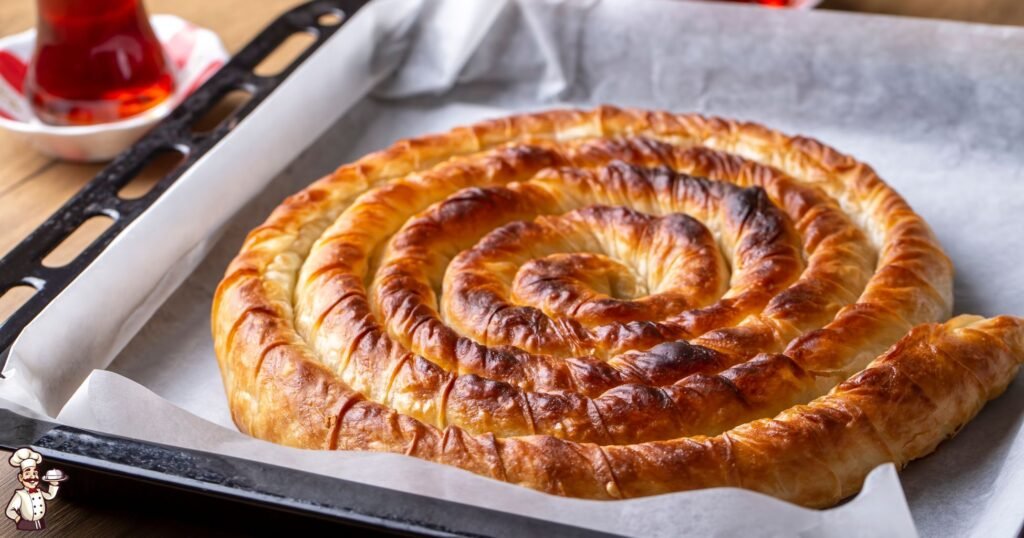Let me share with you the joy of making borek from scratch—a truly satisfying experience that brings out rich flavors and textures. This recipe is all about achieving that crunchy, golden perfection while keeping the layers thin and delicate. The secret lies in the phyllo dough, which, when prepared the right way, creates beautifully layered sheets that are light yet sturdy enough to hold the delicious feta cheese filling. Don’t worry—there’s an easy method to bring all these layers together, ensuring a perfectly buttery, flaky bite every time.
Delicious Filling Ideas for Borek
One of the best things about borek is how you can make it with different filling options, each bringing unique flavors. A classic choice is cooked onion and ground beef, perfectly seasoned with salt and black pepper for a rich, savory taste. If you love a heartier option, try stir-fried onion with mashed potatoes, balanced with a hint of red pepper flake for extra warmth. For a more traditional touch, a spinach filling creates a lovely combination with the flaky layers. No matter which recipe you choose, each bite is comforting and flavorful—I might even do a video to share more ideas.

Key Ingredients for Cheese-Filled Turkish Borek
For the dough
- Start by combining 1/2 cup of lukewarm water, milk, and vegetable oil (like olive or sunflower or any kind you prefer).
- Add 1 large egg and mix well until smooth.
- Slowly add 4+1/2 cups of all-purpose flour—first put 3+1/2 cups, then use more as needed.
- Knead the mixture to make a soft, unsticky, and playable dough.
- Add 1 tsp salt and baking powder to enhance texture.
- Sprinkle 200gr. wheat or corn starch to prevent sticking and improve layering.
- For extra richness, prepare a pouring mix over the borek using 150gr. butter or a mix of 1/3 vegetable or olive oil.
- The filling is crucial—use 250gr. feta cheese or a mixed blend of mozzarella, kashar, or any melting cheese.
- Add 1/3 bunch of finely chopped parsley for freshness and balance.
- Ensure each layer is coated with butter or oil for a flaky texture.
- Let the dough rest before rolling it out to achieve the best results.
- Layer everything carefully to create a beautifully textured borek.
Key Ingredients for Cheese-Filled Turkish Borek
For the dough:
- In a bowl, put 1/2 cup lukewarm water, 1/2 cup milk, and 1/2 cup vegetable oil (you can use olive or sunflower oil or any kind you prefer).
- Add 1 large egg and whisk until well combined.
- Start with 3+1/2 cups all-purpose flour, then use more as needed to make soft, unsticky, and playable dough.
- Mix in 1 tsp salt and 1 tsp baking powder to enhance the texture.
- Gradually add 200gr. wheat or corn starch to prevent sticking and create thin layers.
- Knead the dough gently, ensuring it becomes smooth and elastic.
- If needed, sprinkle more starch to make rolling easier.
- Allow the dough to rest for a short while before shaping.
- Once ready, divide it into portions for rolling.
- Your dough is now prepared for making delicious borek from scratch!
For pouring over the borek dough:
Melt 150gr. butter and mix it with 1/3 vegetable oil or olive oil before pouring it evenly over the layers to give the borek a rich and golden texture.
For the feta cheese filling:
- Use 250gr. of Turkish white cheese and mix it with some mozzarella, kashar, or any kind of melting cheese for a rich flavor.
- Take 1/3 bunch of parsley and finely chop it to add freshness to the filling.
- Blend the ingredients well so that the cheese mixture becomes smooth and flavorful before layering it in the borek.
| Filling Type | Ingredients | Flavor Profile |
| Classic Beef | Ground beef, onion, salt, black pepper | Rich and savory |
| Potato & Onion | Mashed potatoes, stir-fried onion, red pepper flakes | Warm and mildly spicy |
| Spinach & Cheese | Fresh spinach, feta cheese, parsley | Light and fresh |
| Mixed Cheese | Feta, kashar, mozzarella | Creamy and tangy |
“Cooking is an art, and borek is a masterpiece of crispy, golden layers.”

Step-by-Step Guide to Making Borek
- In a mixing bowl, add an egg, lukewarm water, milk, and vegetable oil, then mix with about 4 cups flour, salt, and baking powder. Begin to knead the mixture to form a soft, playable, unsticky dough, adding more flour if needed.
- Take out the dough onto a starch-sprinkled board, cut in half, then divide each half into 5 pieces and shape them into balls. At this point, use only starch to prevent sticking.
- Roll out each dough piece using a rolling pin until the size of a salad plate, sifting plentiful starch over every layer. You will get two batches of thin layers.
- Make sure there is enough starch between the layers because it will help create the thin texture later. Beginning with the first batch, roll together again until it’s much bigger than the pan you are going to use, whether round or rectangular—it doesn’t matter.
- Fit inside the pan, placing the sides over it, separating some layers if possible, and fill with the cheese filling. I used feta cheese, chopped parsley mixture, but you can also use different cheeses, spinach, minced meat, onions, and simple seasonings.
- Repeat the steps with the second batch, this time keeping the top layer intact. Cut the borek into squares, then melt butter and olive oil and pour over the borek.
- Bake in a preheated 180C-degree oven for about 40 minutes until it turns golden on top and bottom. Serve warm after 10-15 minutes out, and for leftovers, store in an airtight container and reheat both sides in a closed lid pan to regain crunchiness. Enjoy with Turkish tea.
The Importance of Starch in Borek Layers
One of the most crucial ingredients in making borek is starch, which plays a key role in achieving those thin, delicate layers. By generously sprinkling starch between each dough layer, you prevent them from sticking together, allowing air pockets to form when baked. This technique is similar to making baklava, where thin sheets are separated to create a crisp, flaky texture. Whether you use wheat or corn starch, the key is to be generous, ensuring that each layer remains distinct, leading to a light and airy borek.
| Starch Type | Purpose |
| Wheat | Helps layers separate evenly |
| Corn | Adds extra crispiness |
“Great borek is all about layers—each one holding a bit of history and tradition.”
Pro Tips for Achieving the Perfect Flaky Borek
To ensure your borek turns out flaky and golden, always use lukewarm water when mixing the dough, as it helps to create a smooth and elastic texture. When rolling out the dough, keep your hands and surface well-dusted with starch to prevent sticking. If you prefer extra crispiness, brush the top with a mix of butter and olive oil before baking. Another tip is to let the baked borek rest for 10-15 minutes before cutting, as this helps the layers set, preventing them from breaking apart too easily.
How to Store and Reheat Borek Properly
If you have leftover borek, store it in an airtight container at room temperature for up to 2 days or in the refrigerator for up to 5 days. To reheat, place it in a dry pan over medium heat with the lid closed—this brings back the crispiness without drying it out. Avoid microwaving, as it makes the layers soggy. If you’re planning to freeze borek, wrap individual portions tightly and reheat them in the oven at 180°C (350°F) until warm and crispy again.

How to Store and Reheat Borek for Maximum Crispiness
Across Turkey, different regions have their own unique borek recipes. In Istanbul, you’ll find Su Böreği, a soft, layered version where the dough is boiled before baking. The Anatolian-style borek is often made with a thicker, more rustic dough and filled with minced meat or spinach. In coastal regions, lighter variations include seafood or herbed cheese fillings. No matter which version you try, borek remains a staple in Turkish cuisine, enjoyed with a glass of strong Turkish tea.
Watch the Borek Recipe Video for Easy Instructions
Notes
There are many filling options you can use for this borek recipe. A classic choice is cooked onion with ground beef, seasoned with salt and black pepper for a rich flavor. Another delicious option is stir-fried onion mixed with mashed potatoes, red pepper flake, and salt, giving a soft and mildly spicy taste. If you love greens, spinach filling is a traditional and lovely choice that goes perfectly with borek. I might do another video to show more fillings you can make at home.
Frequently Asked Questions About Borek
What is borek, and why is it popular in Turkish cuisine?
Borek is a traditional Turkish pastry made with thin layers of dough filled with ingredients like cheese, meat, or vegetables. It’s popular due to its rich, crispy texture and versatility—it can be served for breakfast, lunch, or as a snack. Borek has been a staple in Turkish cuisine for centuries, with variations found across the country.
Is it possible to use store-bought phyllo dough instead of making it from scratch?
Yes! While homemade dough gives a more authentic taste, store-bought phyllo dough is a great shortcut. Just be sure to brush each layer with melted butter or oil to maintain the flaky texture.
What are the best cheese options for a delicious borek filling?
Traditional borek uses Turkish white cheese (similar to feta), but you can also use a mix of kashar cheese, mozzarella, or even ricotta. A combination of feta and mozzarella works well, balancing saltiness with a gooey melt.
Can I prepare borek ahead of time and bake it later?
Absolutely! You can assemble the borek, cover it well, and refrigerate it for up to 24 hours before baking. You can also freeze it unbaked for longer storage—just bake it directly from frozen, adding a few extra minutes to the baking time.
What’s the secret to achieving perfectly flaky and crispy borek layers?
The key to flaky borek is using starch between layers, which prevents them from sticking together and creates air pockets when baked. Brushing each layer with butter or oil also enhances crispiness.
How do I store and reheat borek without losing its crunchiness?
Store borek in an airtight container at room temperature for up to 2 days or in the fridge for up to 5 days. To reheat, warm it in a pan with the lid closed or in the oven at 180°C (350°F). Avoid microwaving, as it makes the layers soggy.
What are some traditional and creative filling variations for borek?
Classic fillings include ground beef with onions, spinach with feta, and mashed potatoes with sautéed onions. You can also experiment with mushrooms, zucchini, or even smoked salmon for unique flavors.
Can I make borek without using butter for a lighter version?
Yes! You can use olive oil instead of butter for a lighter, healthier version. This will still give you crispy layers, though the flavor will be slightly different.
What are the differences between su böreği and the baked version of borek?
Su böreği is a special type of borek where the dough is boiled before layering, giving it a softer, more pasta-like texture. The baked version (such as your recipe) is crispier and flakier.
Is borek traditionally eaten for breakfast, lunch, or dinner?
Borek is a versatile dish enjoyed at any time of the day. It’s commonly eaten for breakfast with Turkish tea, served as a light lunch, or enjoyed as a snack with yogurt or ayran.
Conclusion
Borek is more than just a pastry—it’s a delicious tradition that brings people together with its rich flavors and delicate, flaky layers. Whether you choose a classic cheese filling, a hearty meat variation, or a fresh spinach mix, each bite offers a taste of Turkish culinary heritage. By mastering the dough and layering techniques, you can create a perfectly crispy, golden borek that rivals any bakery. With endless filling possibilities and simple storage and reheating tips, borek is a versatile dish that can be enjoyed at any time of the day. So, gather your ingredients, embrace the process, and savor the satisfaction of making homemade borek from scratch!

Chef Ceren Narin is a passionate food lover and traveler dedicated to sharing authentic Turkish cuisine. As the founder of TurkishYum.com, she explores traditional flavors, recipes, and culinary heritage, bringing the magic of Turkey’s food culture to your kitchen.

